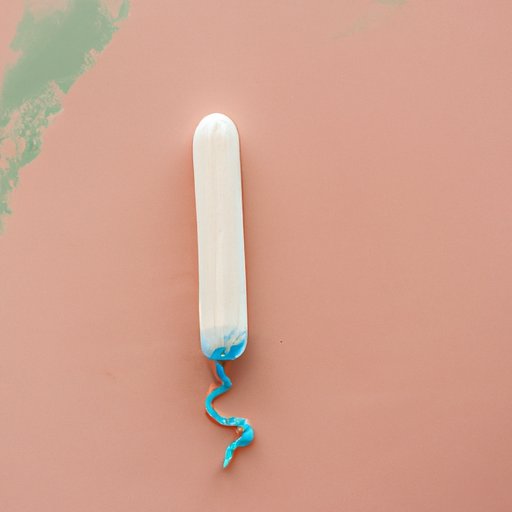
Introduction
As a menstruating person, understanding how long you can have a tampon in is crucial for your menstrual health. Wearing a tampon for too long can lead to potential health risks, but it can be confusing to know what’s safe and what’s not. In this article, we’ll dive into the basics of tampon use duration, health risks associated with prolonged wear, how to tell when your tampon needs to be changed, and alternative menstrual products to consider. We’ll also debunk common myths about tampon use and provide tips for safe and comfortable tampon use over time.
The Basics: Understanding Your Tampon’s Lifespan
Tampons work by absorbing menstrual fluid from the vaginal canal. Different tampons have varying absorbency levels, from light to super-heavy, to accommodate your flow level. When inserted properly, tampons can be worn for up to eight hours. However, the duration of wear ultimately depends on your menstrual flow and the tampon’s absorbency level. Here’s a general breakdown of how long you can wear different types of tampons:
- Light tampons: 4-6 hours
- Regular tampons: 6-8 hours
- Super tampons: 8 hours or less
- Super plus tampons: 4-6 hours
It’s important to note that everyone’s menstrual flow is different, so you may need to change your tampon more or less frequently than the average recommended time. Listen to your body and adjust your tampon use accordingly.
What Happens When You Leave a Tampon in Too Long?
While tampons are a convenient menstrual product, leaving them in for too long can lead to potential health risks, including an increased risk of bacterial infections and Toxic Shock Syndrome (TSS).
TSS is a rare but serious condition that can be caused by leaving a tampon in for too long. TSS can occur when bacteria, usually Staphylococcus aureus, enters the bloodstream and releases toxins. Symptoms of TSS include high fever, vomiting, diarrhea, dizziness, and a rash resembling a sunburn. If you experience any of these symptoms while wearing a tampon, remove it immediately and seek medical attention.
How to Tell If Your Tampon Needs to be Changed
It’s essential to change your tampon regularly to avoid potential health risks. Here are some signs that your tampon needs to be changed:
- Leaks: If your tampon is leaking, it’s a clear indication that it’s time to change it.
- Odor: A strong odor, especially one that’s fishy or unpleasant, can be a sign of bacterial overgrowth and a need for a new tampon.
- Discomfort: If you’re feeling discomfort or irritation, it could be due to an overly saturated tampon.
- Time: If it’s been eight hours or more since you last changed your tampon, it’s time to swap it out for a fresh one.
If you forget when you last changed your tampon, it may be helpful to mark your calendar or use a period-tracking app to keep track of your menstrual flow and tampon use.
The Risks of Extended Tampon Use
Prolonged tampon use can lead to several health problems, including bacterial infections, TSS, and vaginal dryness. By alternating with other menstrual products, such as menstrual cups or pads, you can give your body a break and potentially reduce the risk of these issues.
Alternatives to Tampons for Longer Wear
If you’re looking for alternative menstrual products that can be worn for an extended period, consider menstrual cups or period panties. Menstrual cups are inserted into the vagina and can be worn for up to 12 hours. Period panties are underwear with built-in absorbency that can be worn for up to 12 hours as well. Pads are another viable option that can be comfortably worn for several hours.
Myths and Facts About Tampon Use Duration
There are several myths surrounding tampon use duration that can be misleading. Let’s clear up some common misconceptions:
- Myth: You can wear a tampon for up to 24 hours.
- Fact: Tampons should be changed at least every eight hours to avoid potential health risks.
- Myth: Tampons can get lost in your body.
- Fact: Tampons cannot get lost in your body. They have a string attached that allows you to remove them easily.
- Myth: You should wear the highest absorbency tampon available.
- Fact: It’s important to use the absorbency level that matches your menstrual flow. Wearing a higher absorbency tampon than necessary can increase the risk of TSS.
Tips for Safe and Comfortable Tampon Use Over Time
Here are some general tips to keep in mind for safe and comfortable tampon use:
- Wash your hands: Wash your hands with soap and warm water before inserting or removing a tampon to reduce the risk of bacterial infections.
- Alternate with other menstrual products: Give your body a break by alternating tampons with menstrual cups, pads, or period panties.
- Never double up on tampons: Using two tampons at once can be uncomfortable and increase the risk of infection.
- Remove your tampon before going to bed: It’s best to remove your tampon before sleeping and switch to a pad or menstrual cup for overnight use.
Conclusion
Understanding how long you can have a tampon in is essential for your menstrual health. It’s crucial to change your tampon regularly to avoid potential health risks, and to pay attention to your body’s needs. Alternating with other menstrual products and using proper insertion and removal techniques can also promote safe and comfortable tampon use over time. Prioritizing your menstrual health is always a top priority, and with the right knowledge and tools, you can ensure a comfortable, safe, and healthy period.





